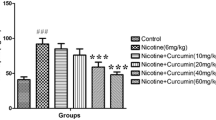Abstract
The central nervous system (CNS) is highly dependent on adequate supply of oxygen and is sensitive to hypoxia. It is known that hypoxia induces injuries on the brain tissue and the neuronal activity. Curcumin, a yellow pigment obtained from the rhizome of C. longa Linn., has been regarded as a multi-functional drug with antioxidative activity. In the present study, we first demonstrated a significant decrease in the content of β-III tubulin protein in rat prefrontal cortex (PFC) tissues induced by repeated hypoxia, but not in rat cerebellum tissue. These suggest a relatively higher sensitivity and probably a higher vulnerability of rat PFC tissue to hypoxia in vivo. We reconfirmed the effect of hypoxia to primary cultured neurons from rat PFC and found a significant decrease in the contents of β-III tubulin protein after chronic exposure to hypoxia. Moreover, we demonstrated that the hypoxia-induced decrease in β-III tubulin protein content could be restored by curcumin, suggesting a potential protection of curcumin against hypoxia-induced decreases in beta-III tubulin content in rat PFC neurons.



Similar content being viewed by others
References
Nieber K (1999) Hypoxia and neuronal function under in vitro conditions. Pharmacol Ther 82:71–86
Matyja E, Kida E (1992) Hippocampal damage in vitro after different periods of oxygen deprivation. Neuropathol Pol 30:231–243
Raley-Susman KM, Murata J (1995) Time course of protein changes following in vitro ischemia in the rat hippocampal slice. Brain Res 695:94–102
Luhmann HJ, Heinemann U (1992) Hypoxia-induced functional alterations in adult rat neocortex. J Neurophysiol 67:798–811
Wallace MG, Hartle KD, Snow WM et al (2007) Effect of hypoxia on the morphology of mouse striatal neurons. Neuroscience 147:90–96
Ruan YW, Zou B, Fan Y et al (2006) Dendrite plasticity of CA1 pyramidal neurons after transient global ischemia. Neuroscience 140:191–201
Fastbom J, Pazos A, Palacios JM (1987) The distribution of adenosine A1 receptors and 59-nucleotidase in the brain of some commonly used experimental animals. Neuroscience 22:813–826
Haddad GG, Jiang C (1994) Mechanisms of neuronal survival during hypoxia: ATP-sensitive K1 channels. Biol Neonate 65:160–165
Bachevalier J, Meunier M (1996) Cerebral ischemia: are the memory deficits associated with hippocampal cell loss. Hippocampus 6:553–560
Kong LW, Jin ZG, Xie ZQ et al (2001) Progress on neuronal tubulins. Chin Bull Life Sci 13:70–73
Kumar K, Wu XL (1995) Expression of β-actin and α-tubulin mRNA in gerbil brain following transient ischemia and reperfusion up to 1 month. Mol Brain Res 30:149–157
Shao G, Gao CY, Lu GW (2005) Alterations of hypoxia-inducible factor-1 alpha in the hippocampus of mice acutely and repeatedly exposed to hypoxia. Neurosignals 14:255–261
Joe B, Vijaykumar M, Lokesh BR (2004) Biological properties of curcumin—cellular and molecular mechanisms of action. Crit Rev Food Sci Nutrition 44:97–111
Masuda T, Maekawa T, Hidaka K et al (2001) Chemical studies on antioxidant mechanism of curcumin: analysis of oxidative coupling products from curcumin and linolate. J Agric Food Chem 49:2539–2547
Reddy AC, Lokesh BR (1994) Studies on the inhibitory effects of curcumin and eugenol on the formation of reactive oxygen species and the oxidation of ferrous iron. Mol Cell Biochem 137:1–8
Unnikrishann MK, Rao MNA (1995) Curcumin inhibits nitrogen dioxide induced oxidation of haemoglobin. Mol Cell Biochem 146:35–37
Nirmala C, Puvanakrishnan R (1996) Effect of curcumin on certain lysosomal hydrolases in isoproterenol-induced myocardial infarction in rats. Biochem Pharmacol 51:47–51
Manikandan P, Sumitra M, Aishwarya S et al (2004) Curcumin modulates free radical quenching in myocardial ischaemia in rats. Intn J Biochem Cell Biol 36:1967–1980
Jiang J, Wang W, Sun YJ et al (2007) Neuroprotective effect of curcumin on focal cerebral ischemic rats by preventing blood-brain barrier damage. Eur J Pharmacol 561:54–62
Maheshwari RK, Singh AK, Gaddipati J et al (2006) Multiple biological activities of curcumin: a short review. Life Sci 78:2081–2087
Lu GW, Liu HY (2001) Downregulation of nitric oxide in the brain of mice during their hypoxic preconditioning. J Appl Physiol 91:1193–1198
Raspaglio G, Filippetti F, Prislei S et al (2008) Hypoxia induces class III beta-tubulin gene expression by HIF-1α binding to its 3′ flanking region. Gene 409:100–108
Choi H, Chun YS, Kim SW et al (2006) Curcumin inhibits hypoxia-inducible factor-1 by degrading aryl hydrocarbon recepteor nuclear translocator: a mechanism of tumor growth inhibition. Mol Pharmacol 70:1664–1671
Acknowledgements
This study was supported by the National Natural Science Foundation of China (NSFC, 30370455, 30470542), National Ministry of Education grant (20040001057), fund of Chun-Tsung Endowment and fund of National Program of Basic Research sponsored by the Ministry of Science and Technology of China (2006CB500706). We thank Xiaodong Liu and Xiong Xiao for their cooperation in animal model construction, Junfeng Hou and Yong Cheng for technical support in neuron culture.
Author information
Authors and Affiliations
Corresponding author
Additional information
Special issue article in honor of Dr. Ji-Sheng Han.
Rights and permissions
About this article
Cite this article
Shen, Y., Yu, LC. Potential Protection of Curcumin against Hypoxia-induced Decreases in Beta-III Tubulin Content in Rat Prefrontal Cortical Neurons. Neurochem Res 33, 2112–2117 (2008). https://doi.org/10.1007/s11064-008-9720-y
Received:
Accepted:
Published:
Issue Date:
DOI: https://doi.org/10.1007/s11064-008-9720-y




